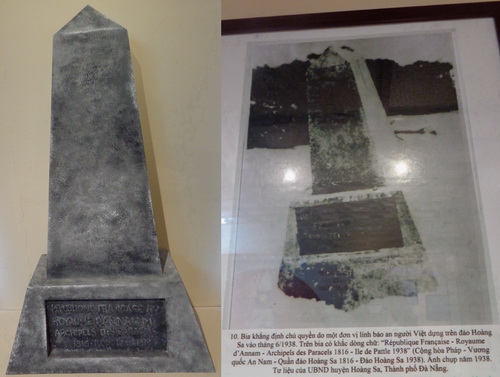The exercise of Vietnam’s sovereignty over Paracel and Spratly Islands in French colonial period (1884-1945)
Since signing the 6 June 1884 Treaty with the Vietnamese Nguyen Dynasty, France had represented Vietnam in all of its external relations and protected Vietnam’s sovereignty and territorial integrity. This is manifested in the signing of Land Delimitation Treaty and the Supplemented Treaty between France and the Chinese Qing Dynasty in 1887 and 1895 respectively. Within the framework of those commitments, Vietnam’s sovereignty over the Paracel (Hoang Sa) and the Spratly (Truong Sa) archipelagoes was exercised by France.
 |
|
A sovereignty stela built by the French in Paracel in 1938 (file photo) |
Since 1920, Indochinese ships of customs, under French protectorate, had intensified their patrol in the area of the Hoang Sa archipelago to prevent smuggling. In 1925, the Institute of Oceanography in Nha Trang and French top scientists first conducted an oceanography survey in the Hoang Sa archipelago to study reefs, marine creature system, monsoon’s effect, and so on. On March 19th, 1926 the Governor of Cochinchina licensed the Tonkin Phosphate Company to do research on natural resources in Truong Sa. These civilian activities specifically demonstrate the continuous and peaceful exercise of Vietnam sovereignty over Hoang Sa and Truong Sa in the early 21st century.
From 1930 to 1938, the French Government deployed naval units to garrison in Hoang Sa islands (in Paracel Islands), major islands of the Truong Sa archipelago, namely An Bang (Amboyna Cay), Song Tu (Northest and Northwest Cay) group, Loai Ta (Loaita Nan), and Thi Tu (Thitu Island) to patrol, build sovereignty stelas, and protect islands. At the same time, it sent major countries diplomatic notifications on French garrisoning in the two archipelagos of Annam. To further consolidate its sovereignty over Hoang Sa and Truong Sa archipelagos, in 1937, the French authorities sent a civil engineer named Gauthier to the Hoang Sa archipelago to examine the positions for building lighthouses and a seaplane terminal, and conditions for inhabitation. One year later (1938), the French completed the constructions of a lighthouse (its international registration No: OMM-48860), a TSF radio station (on Hoang Sa island), 2 meteorological stations; one station on Phu Lam island (in the Paracel Islands), the other on Ba Binh (Itu Aba island) (in the Spratly Islands). These were recognized internationally and frequently used during the period.
For the whole time of representing Vietnam for its external relations, France consistently affirmed the sovereignty of Vietnam over the Hoang Sa and Truong Sa archipelagos, and protested actions that violated this sovereignty. These examples make contributions to claiming that Hoang Sa and Truong Sa archipelagos are inseparable parts of Vietnam’s territory.
Hai Bang